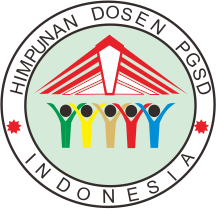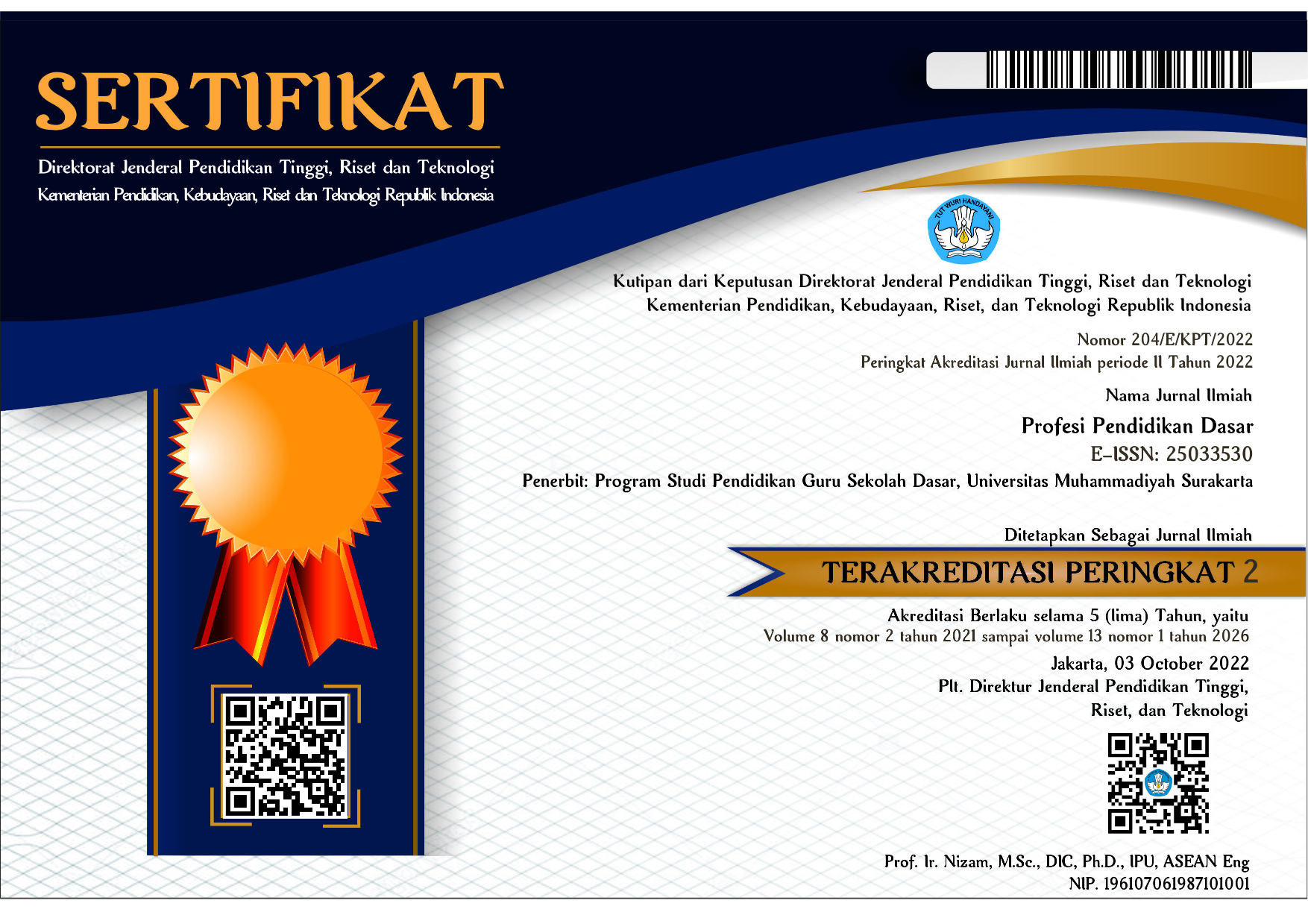Connecting Spatial Reasoning Process to Geometric Problem
Lingga Nico Pradana(1*), Octarina Hidayatus Sholikhah(2)(1) Universitas PGRI Madiun, Madiun
(2) Universitas PGRI Madiun, Madiun
(*) Corresponding Author
Abstract
The field of spatial reasoning has seen a lot of research. The process of spatial reasoning, on the other hand, needs to be investigated further. The goal of this study is to capture an elementary school student's spatial reasoning process when solving geometric problems. The spatial skills used in solving geometric problems were also identified in this study. A geometric test was given to seventeen elementary school students. Three participants were chosen as the study's subjects based on their written responses. According to the findings, the subject's spatial reasoning process always begins with the processing of information in mental visualization. Mental visualization is used to help with orientation and selecting the appropriate visual perspective. The spatial skills of spatial visualization and spatial orientation are critical in spatial reasoning. Furthermore, this research initiated the emphasis on the focus of spatial reasoning in the process.
Keywords
Full Text:
PDFReferences
Akayuure, P., Asiedu-Addo, K. S., & Alebna, V. (2016). Investigating the Effect of Origami Instruction on Preservice Teachers’ Spatial Ability and Geometric Knowledge for Teaching. International Journal of Education in Mathematics, Science and Technology, 4(3), 198–209. https://doi.org/10.18404/ijemst.78424
Cheng, Y. L., & Mix, K. S. (2014). Spatial Training Improves Children’s Mathematics Ability. Journal of Cognition and Development, 15(1), 2–11. https://doi.org/10.1080/15248372.2012.725186
Clements, D. H., & Battista, M. T. (1992). Geometry and spatial reasoning. In D. Grouws (Ed.), Handbook of Research on Mathematics Teaching and Learning (pp. 420–464). National Council of Teachers of Mathematics.
Gilligan, K. A., Flouri, E., & Farran, E. K. (2017). The contribution of spatial ability to mathematics achievement in middle childhood. Journal of Experimental Child Psychology, 163. https://doi.org/10.1016/j.jecp.2017.04.016
Hartatiana, Darhim, & Nurlaelah. (2017). Student’s Spatial Reasoning through Model Eliciting Activities with Cabri 3D. Journal of Physics: Conf. Series, 895, 1–5.
Jones, M. G., Gardner, G., Taylor, A. R., Wiebe, E., & Forrester, J. (2011). Conceptualizing Magnification and Scale: The Roles of Spatial Visualization and Logical Thinking. Research in Science Education, 41(3), 357–368. https://doi.org/10.1007/s11165-010-9169-2
Kovačevi´c, N. K. (2017). Spatial reasoning in mathematics. International Scientific Colloquim Mathematics and Children Founded by Margita Pavleković, 6, 1–21.
Lane, D., Lynch, R., & McGarr, O. (2018). Problematizing spatial literacy within the school curriculum. International Journal of Technology and Design Education, September. https://doi.org/10.1007/s10798-018-9467-y
Lowrie, T., & Jorgensen, R. (2017). Equity and spatial reasoning: reducing the mathematical achievement gap in gender and social disadvantage. Mathematics Education Research Journal. https://doi.org/10.1007/s13394-017-0213-7
Lowrie, T., Logan, T., & Ramful, A. (2017). Visuospatial training improves elementary students’ mathematics performance. British Journal of Educational Psychology, 87(2), 170–186. https://doi.org/10.1111/bjep.12142
Moore-Russo, D., Viglietti, J. M., Chiu, M. M., & Bateman, S. M. (2013). Teachers’ spatial literacy as visualization, reasoning, and communication. Teaching and Teacher Education, 29(1), 97–109. https://doi.org/10.1016/j.tate.2012.08.012
Mulligan, J., Woolcott, G., Mitchelmore, M., & Davis, B. (2017). Connecting mathematics learning through spatial reasoning. Mathematics Education Research Journal. https://doi.org/10.1007/s13394-017-0210-x
NCTM. (2006). Learning to Think Spatially. The National Academies Press. https://doi.org/10.17226/11019
Newcombe, N. S. (2013). Seeing relationships: Using spatial thinking to teach science, mathematics, and social studies. American Educator, 37(1), 26–32.
Peng, A., & Sollervall, H. (2014). Primary school students’ spatial orientation strategies in an outdoor learning activity supported by mobile technologies. International Journal of Education in Mathematics, Science and Technology, 2(4), 246–256.
Pittalis, M., & Christou, C. (2010). Types of reasoning in 3D geometry thinking and their relation with spatial ability. Educational Studies in Mathematics, 75(2), 191–212. https://doi.org/10.1007/s10649-010-9251-8
Ramful, A., Lowrie, T., & Logan, T. (2017). Measurement of Spatial Ability: Construction and Validation of the Spatial Reasoning Instrument for Middle School Students. Journal of Psychoeducational Assessment, 35(7), 709–727. https://doi.org/10.1177/0734282916659207
Smith, N. J. (2009). Language Shift, Gender, and Ideologies of Modernity in Central Java, Indonesia. Journal of Linguistic Anthropology, 19(1), 57–77. https://doi.org/10.1111/j.1548-1395.2009.01019.x
Tariq, V. N., Qualter, P., Roberts, S., Appleby, Y., & Barnes, L. (2013). Mathematical literacy in undergraduates: role of gender, emotional intelligence and emotional self-efficacy. International Journal of Mathematical Education in Science and Technology, 44(8), 1143–1159. https://doi.org/10.1080/0020739X.2013.770087
Tepylo, D. (2017). Examining Changes in Spatialized Geometry Knowledge for Teaching as Early Years Teachers Participate in Adapted ... (Issue July). https://doi.org/10.13140/RG.2.2.17795.60966
van der Henst, J. B. (1999). The mental model theory of spatial reasoning re-examined: the role of relevance in premise order. British Journal of Psychology (London, England : 1953), 90 ( Pt 1), 73–84. https://doi.org/10.1348/000712699161279
Walker, C. M., Winner, E., Hetland, L., Simmons, S., & Goldsmith, L. (2011). Visual Thinking: Art Students Have an Advantage in Geometric Reasoning. Creative Education, 02(01), 22–26. https://doi.org/10.4236/ce.2011.21004
Williams, C., Gero, J., Lee, Y., & Paretti, M. (2010). Exploring spatial reasoning ability and design cognition in undergraduate engineering students. Proceedings of the ASME Design Engineering Technical Conference, 6, 669–676. https://doi.org/10.1115/DETC2010-28925
Yoon, S. Y., & Mann, E. L. (2017). Exploring the Spatial Ability of Undergraduate Students: Association With Gender, STEM Majors, and Gifted Program Membership. Gifted Child Quarterly, 61(4). https://doi.org/10.1177/0016986217722614
Yüksel, N. S. (2017). Visual-spatial Ability in STEM Education (M. S. Khine (ed.)). Springer. https://doi.org/10.1007/978-3-319-44385-0.
Article Metrics
Abstract view(s): 928 time(s)PDF: 499 time(s)
Refbacks
- There are currently no refbacks.


















